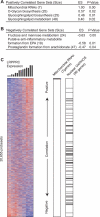Mitochondrial and nuclear genomic responses to loss of LRPPRC expression
- PMID: 20220140
- PMCID: PMC2859537
- DOI: 10.1074/jbc.M109.098400
Mitochondrial and nuclear genomic responses to loss of LRPPRC expression
Erratum in
-
Correction: Mitochondrial and nuclear genomic responses to loss of LRPPRC expression.J Biol Chem. 2020 Apr 17;295(16):5533. doi: 10.1074/jbc.AAC120.013571. J Biol Chem. 2020. PMID: 32303645 Free PMC article. No abstract available.
Abstract
Rapid advances in genotyping and sequencing technology have dramatically accelerated the discovery of genes underlying human disease. Elucidating the function of such genes and understanding their role in pathogenesis, however, remain challenging. Here, we introduce a genomic strategy to characterize such genes functionally, and we apply it to LRPPRC, a poorly studied gene that is mutated in Leigh syndrome, French-Canadian type (LSFC). We utilize RNA interference to engineer an allelic series of cellular models in which LRPPRC has been stably silenced to different levels of knockdown efficiency. We then combine genome-wide expression profiling with gene set enrichment analysis to identify cellular responses that correlate with the loss of LRPPRC. Using this strategy, we discovered a specific role for LRPPRC in the expression of all mitochondrial DNA-encoded mRNAs, but not the rRNAs, providing mechanistic insights into the enzymatic defects observed in the disease. Our analysis shows that nuclear genes encoding mitochondrial proteins are not collectively affected by the loss of LRPPRC. We do observe altered expression of genes related to hexose metabolism, prostaglandin synthesis, and glycosphingolipid biology that may either play an adaptive role in cell survival or contribute to pathogenesis. The combination of genetic perturbation, genomic profiling, and pathway analysis represents a generic strategy for understanding disease pathogenesis.
Figures



Similar articles
-
LRPPRC and SLIRP interact in a ribonucleoprotein complex that regulates posttranscriptional gene expression in mitochondria.Mol Biol Cell. 2010 Apr 15;21(8):1315-23. doi: 10.1091/mbc.e10-01-0047. Epub 2010 Mar 3. Mol Biol Cell. 2010. PMID: 20200222 Free PMC article.
-
Tissue-specific responses to the LRPPRC founder mutation in French Canadian Leigh Syndrome.Hum Mol Genet. 2015 Jan 15;24(2):480-91. doi: 10.1093/hmg/ddu468. Epub 2014 Sep 11. Hum Mol Genet. 2015. PMID: 25214534 Free PMC article.
-
Novel LRPPRC compound heterozygous mutation in a child with early-onset Leigh syndrome French-Canadian type: case report of an Italian patient.Ital J Pediatr. 2020 Sep 24;46(1):140. doi: 10.1186/s13052-020-00903-7. Ital J Pediatr. 2020. PMID: 32972427 Free PMC article.
-
Leigh syndrome: Resolving the clinical and genetic heterogeneity paves the way for treatment options.Mol Genet Metab. 2016 Mar;117(3):300-12. doi: 10.1016/j.ymgme.2015.12.004. Epub 2015 Dec 19. Mol Genet Metab. 2016. PMID: 26725255 Review.
-
LRPPRC: A Multifunctional Protein Involved in Energy Metabolism and Human Disease.Front Physiol. 2019 May 24;10:595. doi: 10.3389/fphys.2019.00595. eCollection 2019. Front Physiol. 2019. PMID: 31178748 Free PMC article.
Cited by
-
Mitochondrial transcription: lessons from mouse models.Biochim Biophys Acta. 2012 Sep-Oct;1819(9-10):961-9. doi: 10.1016/j.bbagrm.2011.11.001. Epub 2011 Nov 18. Biochim Biophys Acta. 2012. PMID: 22120174 Free PMC article. Review.
-
Mitochondrial retrograde signaling connects respiratory capacity to thermogenic gene expression.Sci Rep. 2017 May 17;7(1):2013. doi: 10.1038/s41598-017-01879-x. Sci Rep. 2017. PMID: 28515438 Free PMC article.
-
Transcription-independent role for human mitochondrial RNA polymerase in mitochondrial ribosome biogenesis.Nucleic Acids Res. 2013 Feb 1;41(4):2479-88. doi: 10.1093/nar/gks1447. Epub 2013 Jan 8. Nucleic Acids Res. 2013. PMID: 23303773 Free PMC article.
-
Proteolytic regulation of mitochondrial magnesium channel by m-AAA protease and prohibitin complex.Genetics. 2025 Feb 5;229(2):iyae203. doi: 10.1093/genetics/iyae203. Genetics. 2025. PMID: 39657011
-
Proteomic and transcriptomic analysis of heart failure due to volume overload in a rat aorto-caval fistula model provides support for new potential therapeutic targets - monoamine oxidase A and transglutaminase 2.Proteome Sci. 2011 Nov 11;9(1):69. doi: 10.1186/1477-5956-9-69. Proteome Sci. 2011. PMID: 22078724 Free PMC article.
References
Publication types
MeSH terms
Substances
Associated data
- Actions
Grants and funding
LinkOut - more resources
Full Text Sources
Molecular Biology Databases

